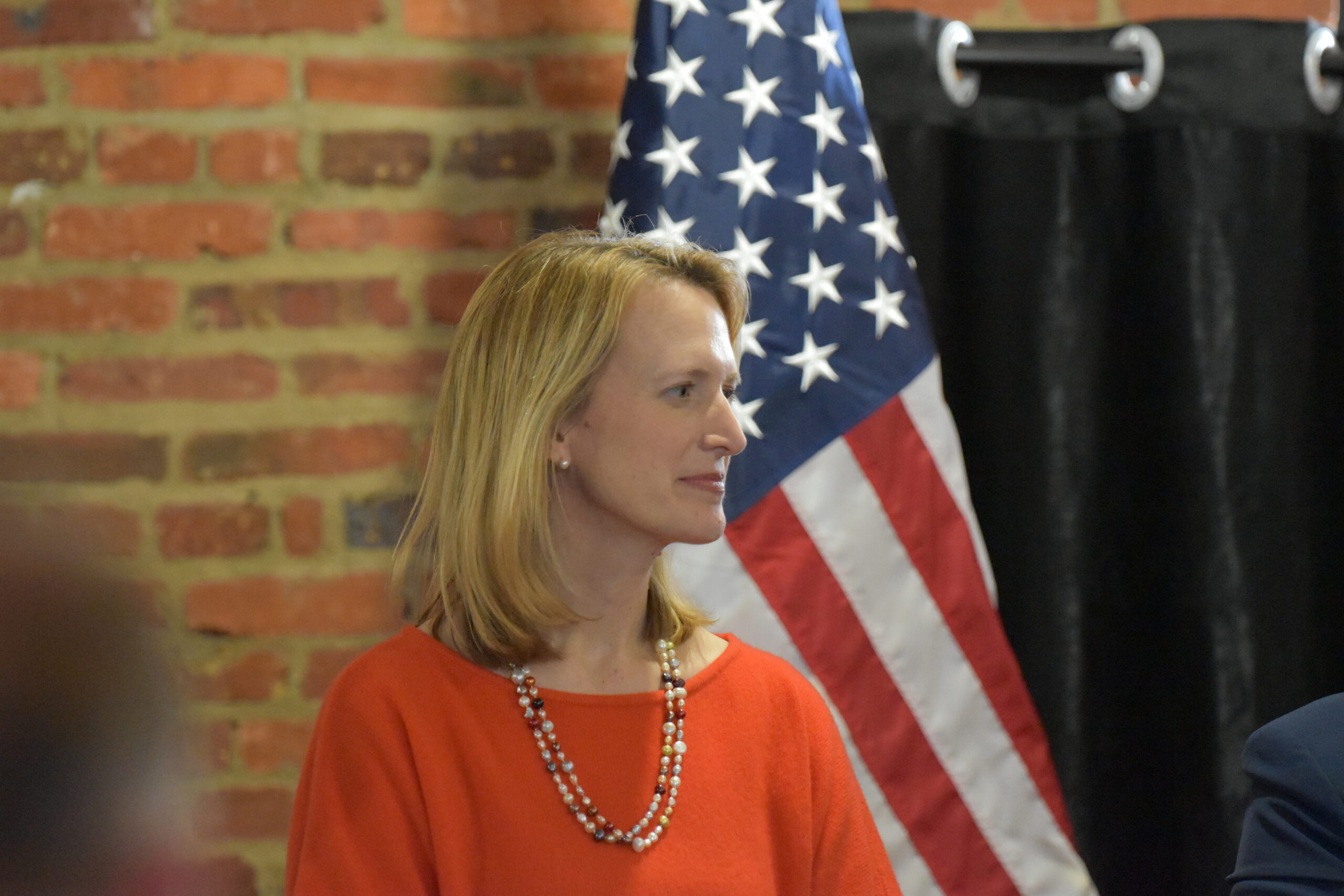
Maryland Comptroller Brooke Lierman (D) is one of the best-prepared politicians in Maryland.
After eight years in the House of Delegates, she took over an 1,100-person agency a year ago with an unfathomably broad portfolio — including being the state’s tax collector and serving on the critically important Board of Public Works — but managed to put her stamp on the department in fairly quick order.
Last week in Annapolis, surrounded by paintings from Maryland artists on display in a conference room in the Treasury Building, Lierman discussed the changes she has brought to the office and her vision for modernizing the agency in the year ahead. On Tuesday, she released a 5-minute video highlighting the work she has done over the past year. The video opens with a look at the framed portraits of many of her predecessors — a reminder that they are all white men.
In the interview with Maryland Matters, Lierman’s well-known wonkiness came through loud and clear. She also laughed a lot. She’s clearly enjoying the job so far.
What follows are excerpts from the interview, lightly edited for brevity.
Maryland Matters: You campaigned with a very clear idea of what you wanted to do in the job and how you wanted the office to run. You must have encountered some surprises — some fun surprises, maybe some unpleasant ones. What surprised you about the job?
Brooke Lierman: You know about the bats, right? [Editor’s note: A bat infestation last year in the Treasury Building] That was the first surprise.
MM: Not an omen, I hope.
BL: No (laughs). If I have to think about one of the biggest overarching surprises about becoming the comptroller and leading an 1,100-person agency with 12 offices is just how dependent this role is on the person who holds the office. Despite the statutory and constitutional mandates, it changes based on the person in office, and to a greater degree than I could have possibly known before I was in the office. If you look at everything from where you focus your resources or spend your time and attention, the work you do to build the divisions in the agency, the budget asks you make — the statutes and the constitution set up the building blocks of the job, but what is built depends entirely on the person that the voters elect…There is so much work and so many different types of work that this agency does, it’s pretty fascinating.
MM: Did your agenda come together the way you wanted it to?
BL: I feel very fortunate in that I had a very robust transition team, and we went through a very intentional transition process where our workgroups learned the different parts of the agency and we were able to produce a very comprehensive transition report that laid out where the agency was and ideas for moving different pieces forward…Going through that transition process enabled me to meet the goals that I had and also enabled me to meet the goals I had heard from the people who worked at the agency, that we needed to reorganize the leadership structure of the agency.
The organization used to have the comptroller, deputy comptroller, chief of staff…We went from having one deputy comptroller and a chief of staff with four deputy chiefs of staff, and we took those [positions] and said we need to have four deputy comptrollers that each have their own clear line of work. So there’s four departments now and each department is led by a deputy comptroller, except for our IT department, which is led by our agency’s first-ever CIO.
And we created the role of chief equity and transformation officer..and her portfolio includes fair practices work, but also ensuring inclusivity and diversity, that they’re front of mind as we’re building out and transforming the agency. It will also soon house our CompStat director.
We’re just hiring a director now, and we’re really excited to bring that person in to our equity and transformation office and lead us down a data-driven approach to doing our work in a more efficient way.
MM: Will there be particular things that this person is monitoring?
BL: The first part of the job will be to work with every deputy comptroller and each director under the deputy comptroller to identify the metrics in their division that they should be measuring. And then we will measure (laughs), and we will improve and work to improve.
I am really proud and humbled by the people who said yes, the people who joined the team — from our CIO, who was Baltimore County’s CIO for 20 years and did amazing work there, to our chief equity officer…We have a brand new Board of Public Works director. What you can get done in an agency is so dependent on who you hire, so I have tried very hard…to ensure that we’re recruiting the best people for the jobs who also represent Maryland. So I feel really lucky and very excited that so many people said yes to working in the Maryland comptroller’s office.
MM: Very few people come into this job having managed an entity of this size, so I imagine that was a challenge and an eye-opener.
BL: On the campaign trail, you don’t think too much about how you’re going to manage the team, because it’s hard to understand it until you’re actually there. I love the CEO role of the job and working with our team members. I’m so impressed by the work that our team members do, from the call centers to the taxpayer services team to the folks on the road testing fuel to central payroll. I am so inspired and humbled by the work that they do, and one of my goals has been to answer their requests to build an agency that communicates more, that appreciates its team members and lifts them up, and that offers them continuous training and education so that you can continue to work and continue to grow here at the agency…
Modernizing is what we are really focused on — modernizing the agency, increasing our public engagement so we can better work with individuals…We created a new vision statement for the agency, to create a state that’s more equitable, more resilient and more prosperous, so that every Marylander can reach their full potential. Under that, we created three core priorities. First is making government work better, then making sure that the expertise and resources of the office are reaching the people of Maryland. Third is ensuring that we are building a stronger Maryland over the long term. Within each of those core priorities we’re being very intentional about the work that we do. Focusing on procurement and [minority business enterprise programs]. Focusing on investment and climate risk. Focusing on partnerships with other agencies.
MM: Do you anticipate that when CompStat gets set up, you’ll be measuring those things as well?
BL: We need to learn to flex our metric muscle, which is a phrase I learned from [Maryland Human Services] Secretary [Rafael] Lopez. I love it and I use it all the time. We are an agency that relies on numbers and we need to understand the metrics in each of our divisions. It’ll look different in different places. Taxpayer services — we’ll follow the phone calls we’re getting, the emails we’re getting, resolution. In Board of Public Works, we would like to build a public facing website where people can do more detailed searches, do a database of procurement, so people don’t have to work on a PDF.
Looking ahead, in the bucket of modernizing, the first big thing is Maryland Tax Connect is going to launch on Feb. 6. It will be our brand new, online tax portal. We did an in-house contest for the name and logo (laughs). It was fun. So many entries, from all corners of the agency. Even a couple of lawyers (laughs). It will be open first for all business taxes, so we will begin processing business taxes in a new cloud-based system, including cannabis. It will take another 18 months or so to bring in personal income taxes. By the end of my term, all taxpayers will be in a brand new system…
Our second big modernization work will be CompStat, which is internal. Also we’ll be launching a new website this year…Our goal is to make it a more interactive website with more resources for individuals who want to start a business, or do business with the state or have tax questions. We want to make it more interactive and more useful. We also got last session from the legislature funding for a taxpayer advocate office, so we’ll get the [positions] for that hopefully in this year’s budget.
MM: How many [positions] ideally do you envision?
BL: We had two in an ombudsman office that we will transition into a taxpayer advocate office and then we asked for four more, so six. They both do work digging in on complex tax challenges and problems and will also work with the CompStat director to understand what challenges Marylanders are having generally with their taxes and do internal policy work to troubleshoot.
On the procurement side, I’m really excited on the work we’ve done with the Board of Public Works to focus on MBEs [minority business enterprise goals], which I think is about building a more inclusive economy and also a more resilient one. In this past year, even with a 52% decrease in expenditures from the Board of Public Works, we increased expenditures going to MBEs by $160 million. But there’s a lot more to do…we need to continue doing outreach to MBEs, so they know how to get certified and can apply, and to hold our agencies and ourselves accountable. And we also need to map the procurement economy so we know where the opportunities are…
On the pension side…I’m keenly interested in in-state investing. I want to work with the treasurer and the pension board to do an analysis of setting up an in-state investment program. Many states have them set up already and I think it’s an important way to ensure that we have capital available while also making good returns with the fund and supporting Maryland-based businesses. It can be a win-win for the state and for Maryland retirees.
I’m very focused on making sure we can partner with other state agencies and local governments. We administer the senior tax credit, so we want to make sure we’re communicating the requirements for that to the Department of Aging so that they can help us ensure that seniors know about it. We are very focused on working with the Governor’s Offrice of Small Business, to let them know about the resources the state has and procurement options. That type of work — finding ways we can partner is important to me because it helps us serve Marylanders in a more cohesive and efficient way.
And finally, working to support and build the team…We hired our first-ever training director for the agency.
MM: Does that person actually conduct trainings or identify appropriate trainings for people in different sectors of the agency?
BL: More the latter. We do have some really good trainings, but not enough options. So bringing in somebody really good who would make that their sole focus, auditing the trainings we have now, communicating with staff to find out what they want, identifying gaps and finding resources to fill those gaps in training, especially in leadership and management.
We have a new Office of Public Engagement, so we have teams digging in with other groups to make sure they know about the resources of the office.
I love the job. It’s such an honor to both lead an agency of such dedicated people and to also be entrusted with the responsibilities, the financial responsibilities I have for Marylanders.
MM: The financial responsibility part must be daunting. I don’t know if you feel as if you have to be the prophet of doom sometimes.
BL: (Laughs). It’s less doom and more pragmatism, I would say. We’re Maryland. We have the lowest unemployment rate in the country. We’re very wealthy. We have the lowest poverty rate in the country. We have, I would argue, one of the most unique mixes of private and federal sectors in the country, between our incredible universities, our biotech, quantum, and then the dozens of federal government agencies we have located here. It’s pretty phenomenal. We’re very fortunate. I was really proud of the information we put out in our State of the Economy report, in both quantitative data that we put out and qualitative data based on hundreds of conversations that we had with business leaders and community leaders, all across the state. It painted a really clear and important picture of the benefits we have, the opportunities we have and the challenges we need to overcome.
MM: Going back to the expectations question, how has it been being on the Board of Public Works? The dynamics, the interplay between the three of you, the theater of it?
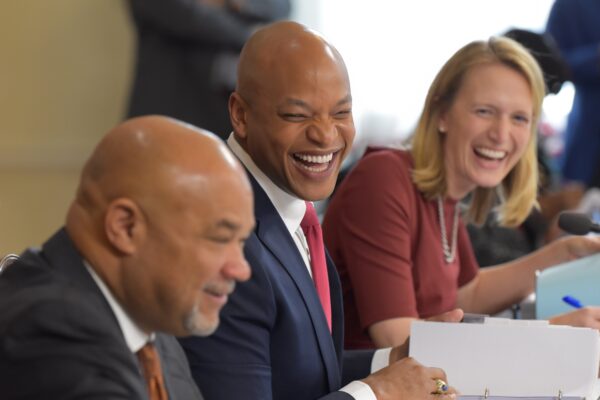
The Maryland Board of Public Works including Treasurer Dereck Davis (D), Gov. Wes Moore (D), and Comptroller Brooke Lierman (D). Photo by Bryan P. Sears.
BL: We’ve tried to make it less theatrical (laughs).
MM: I appreciate that.
BL: My first Board of Public Works meeting was very surreal. It was surreal walking out there and being on that side of the table and seeing the cameras. But I take it incredibly seriously. We have a new Board of Public Works director…and the staff digs in on every item. It’s so interesting because sometimes we get the agenda and it will look so mundane, then we’ll dig in and we’ll find multiple contracts where we have serious questions. We spend a lot of time going through each item, talking to the agencies. They have gotten to know now how detailed an analysis we want on each of their contracts…And that we are going to push, along with the treasurer and the governor, on the MBE question, making sure that we understand why a goal was set and how the contractor that they’ve picked is going to meet it.
Also, we have encouraged our agencies to think about when they don’t have to contract out work and should think of ways of using state capabilities to do the work, which in the long run is a better deal for the state. We have also encouraged the agencies to start digging in more on the climate resiliency projects that they’re doing, so that they are in line with [the] Climate Solutions Now [Act of 2022]. So we’re going to keep pushing on breaking out the climate, sustainability and resiliency efforts of our agencies when we’re spending money, to make sure we’re planning for decades.
MM: Have you encountered resistance to that or is it just a new thing?
BL: It’s just a new thing. It’s something that hasn’t been done and many agencies are already doing it internally but haven’t communicated it before or have not written it down. It’s already a part of their process but they haven’t necessarily been able to articulate that, so we want to make sure that we’re lifting up those efforts and making sure everybody can see we’re being intentional about this work…Everybody has a role to play.
MM: Talk a little more about pensions and investments and the climate.
BL: I wrote the bill, which mandates the pension system to take climate risk and view it as investment risk. And also to identify opportunities in the new green economy. So when I come across opportunities I send them along to our CIO, and they do an investigation. We’ve been working to think through how to educate our [pension] board on climate needs and investment challenges…We hired a governance director, and she’s helping to strengthen environmental language in our investment offering documents as well. It’s like turning around a cruise ship. But we are making strides and I’m proud of the work our pension system is making on this. The bill we passed is really a national model for other states now to make sure they’re being good fiduciaries by understanding the climate risk and how it is investment risk.
MM: Since we’re in the legislative session, are there bills that you’re promoting that deal with the governance of your agency or broader subjects?
BL: We will bring a few bills this year. One is making sure we’re protecting Marylanders from scam tax preparers and to really strengthen oversight — our ability to do oversight, the Department of Labor’s ability to do oversight, and to work with us to oversee tax preparers.
We also want to make sure that we are educating and doing outreach to Marylanders who are owed tax credits that they’re not applying for. For example, the EITC [earned-income tax credit]. In some other states they’ve done outreach to every person who has filed for the federal EITC and but not the state EITC. Or Medicaid recipients who have not filed for the EITC. The EITC can be a really important part of helping working families make ends meet or moving them out to a higher tax bracket.
We’re also working on our budget request and really focused on creating a compliance team that will help close the tax gap in Maryland. That’s a $9 billion gap. But we have a whole plan to help close the known tax gap in Maryland. But the unknown tax gap, which is income that we don’t even know we’re missing…there is new technology that we’d like to bring in to help us scrape publicly available data and make sure people are paying their fair share.
MM: So how do your kids like you being comptroller? Are you seeing them more or less than you did before?
BL: Well, the other day, my daughter was selling Girls Scout cookies —
MM: So you have 1,100 people to sell to —
BL: (Laughs) No, just in the neighborhood. And she turned to me and said, “Mom, what about sales tax?” (Laughs) And I said, “Yep, that’s part of it.” We joke that they’re the only kids in their classes who know what taxes are and know that the comptroller of Maryland is the tax collector.

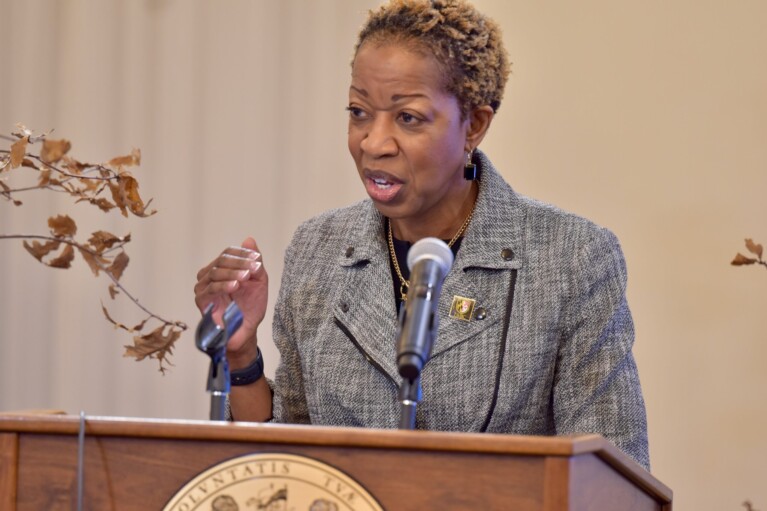
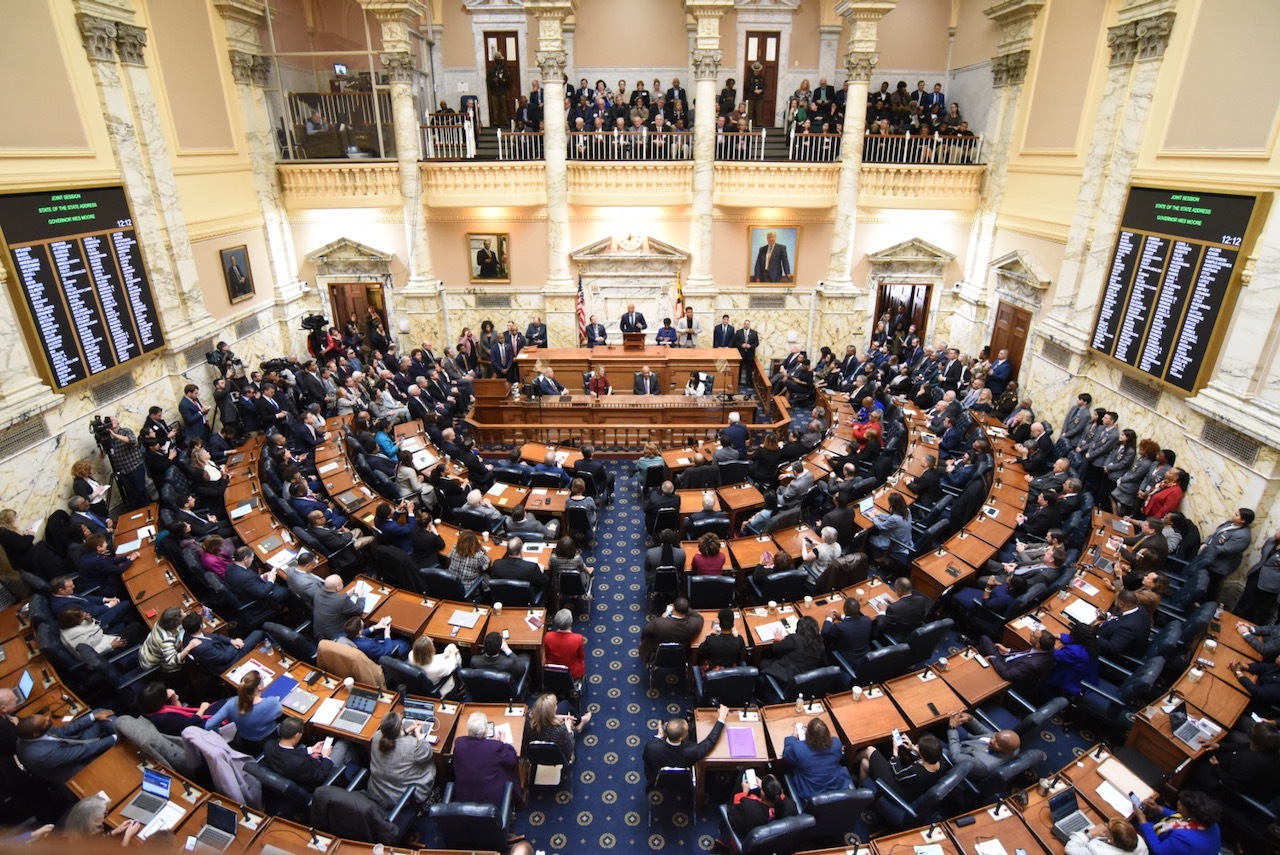
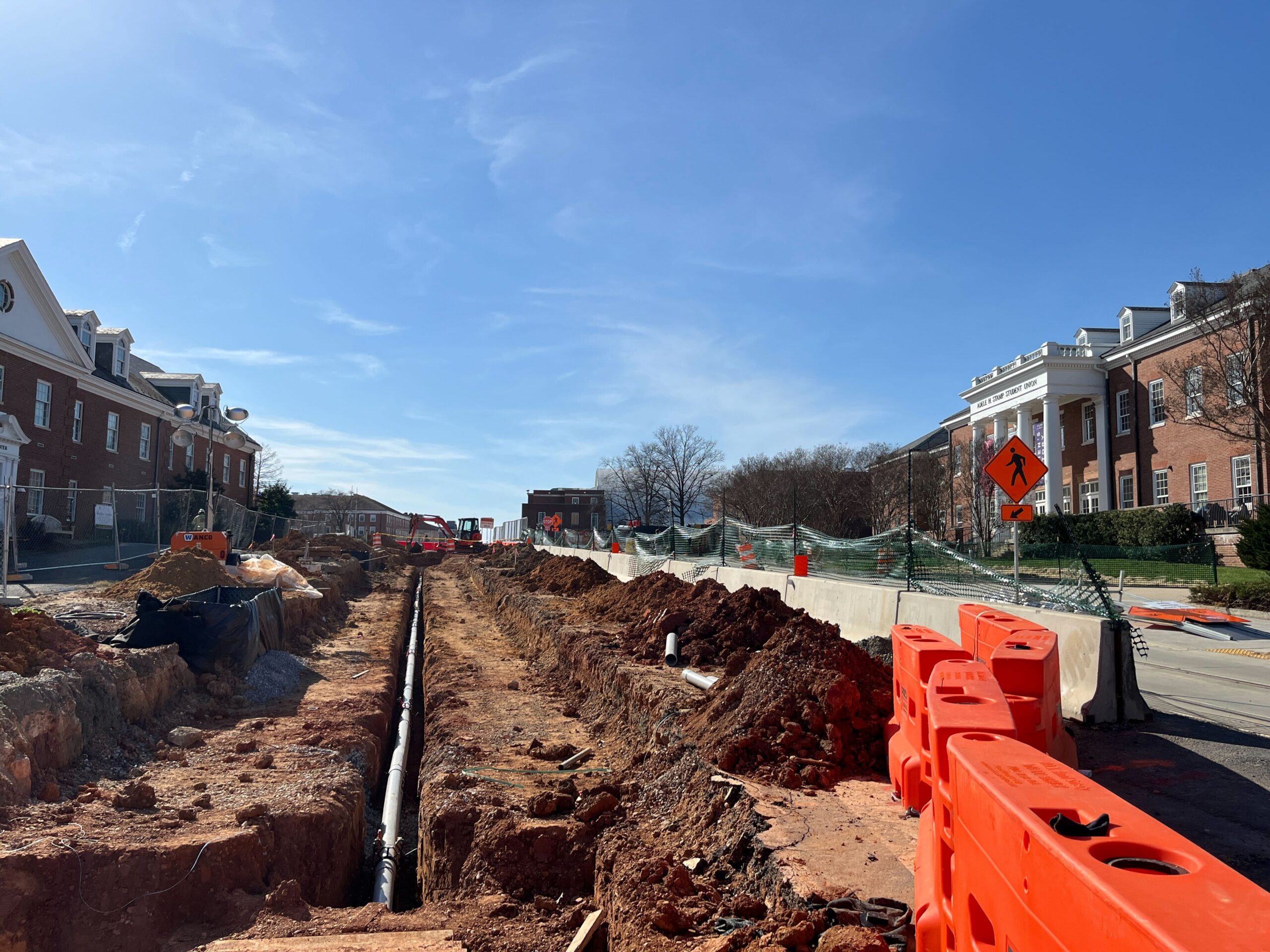
 Creative Commons Attribution
Creative Commons Attribution